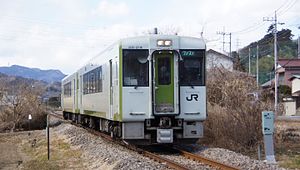|
Hachikō Line
The Hachikō Line is a 92.0 km (57.2 mi) regional railway line owned and operated by East Japan Railway Company (JR East). It is located within Tokyo, Saitama, and Gunma Prefectures in Japan. It connects Hachiōji Station in Hachiōji, Tokyo with Kuragano Station in Takasaki, Gunma Prefecture. ServicesKomagawa Station in Hidaka, Saitama is the boundary point between two distinct sections. The southern section from Hachiōji to Komagawa is electrified at 1,500 V DC. Some trains terminate at Komagawa, while others continue over the Kawagoe Line to Kawagoe Station. The non-electrified northern section connects Komagawa with Kuragano. All trains continue on the Takasaki Line to Takasaki, where transfer to the Jōetsu Shinkansen is available. There are no through services connecting the southern and northern halves of the line. The Hachikō Line takes the first kanji of its name from the first character of Hachiōji (八王子) and the second kanji from the first character of Takasaki (高崎). Stations
Hachiōji - Komagawa
Komagawa - Takasaki
Rolling stock
From 2017, former E231-0 series ten-car sets based at Mitaka Depot for use on Chūō–Sōbu Line services were reformed and converted to become four-car E231-3000 series sets based at Kawagoe for use on Kawagoe Line and Hachiko Line services.[2] The first set entered revenue service on the line on 19 February 2018.[3] From 2018, former 209-500 series ten-car sets based at Mitaka Depot for use on Chūō–Sōbu Line services were reformed and converted to become four-car 209-3500 series sets based at Kawagoe for use on Kawagoe Line and Hachiko Line services.[4] Rolling stock previously used
HistoryThe first section of the line, named the Hachikō North Line (Japanese: 八高北線, Hepburn: Hachikō-kita-sen), opened from Kuragano to Kodama on 1 July 1931, followed by the section from Hachioji to Higashi-Hanno, named the Hachikō South Line (Japanese: 八高南線, Hepburn: Hachikō-minami-sen), on 10 December 1931.[1] The Hachiko North Line was extended southward from Kodama to Yorii on 25 January 1933, and the Hachiko South Line was extended northward from Higashi-Hanno to Ogose on 15 April 1933.[1] The Hachiko South Line was further extended northward from Ogose to Ogawamachi on 24 March 1934, and the last section between Ogawamachi and Yorii opened on 6 October 1934, connecting the north and south sections, and completing the entire line, which became known simply as the Hachiko Line.[1] All passenger operations were switch from steam haulage to electric trains from 20 November 1958.[1] CTC signalling was commissioned over the entire line from 27 February 1985.[1] On 1 April 1987, with the privatization and splitting of Japanese National Railways (JNR), the Hachiko Line was transferred to the ownership of JR East.[1] From 16 March 1996, the Hachioji to Komagawa section was electrified at 1,500 V DC, and services on the non-electrified section north of Komagawa to and from Takasaki were operated separately as one-man driver only operation services using KiHa 110 series DMUs,[1][7] and the southern section began through service operations to the Kawagoe Line to Kawagoe Station. Also from the same date until 11 March 2022, some morning rush hour services left the Hachikō Line at Haijima Station and travel to Tokyo via the Ōme Line and Chūō Line; the reverse happened during the evening rush. Starting 12 March 2022, the southern section from Hachiōji to Komagawa (and through services to the Kawagoe Line) began one-man driver only operation services using the existing 209-3500 and E231-3000 series EMUs. Former connecting lines
AccidentsIn 1945, a head-on collision at the Tamagawa bridge resulted in 105 fatalities.[citation needed] The Hachiko Line derailment in 1947 is Japan's worst rail accident since World War II in terms of fatalities. ReferencesWikimedia Commons has media related to Hachikō Line.
|
||||||||||||||||||||||||||||||||||||||||||||||||||||||||||||||||||||||||||||||||||||||||||||||||||||||||||||||||||||||||||||||||||||||||||||||||||||||||||||||||||||||||||||||||||||||||||||||||||||||||||||||||||||||||||||||||||||||||||||||||||||||||||||












